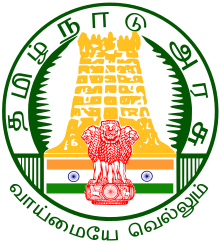The Department of Energy of state of Tamil Naduis one of the departments of Government of Tamil Nadu. The department was established in 1993 and is responsible for the production and distribution of energy.
 | |
| Agency overview | |
|---|---|
| Formed | 1993 |
| Jurisdiction | Tamil Nadu |
| Headquarters | Chennai |
| Minister responsible |
|
| Agency executive |
|
| Parent agency | Government of Tamil Nadu |
| Website | Energy Department |
Objective
editThe department is responsible for the production and distribution of power. It enables power production from various resources and distribution of the same through various agencies and undertakings.[1]
Power production, distribution and transmission
editTamil Nadu Electricity Board (TNEB) is the nodal agency of power generation and distribution. It includes two undertakings: Tamil Nadu Generation and Distribution Corporation (TANGEDCO) and Tamil Nadu Transmission Corporation (TANTRANS).[2] As of 2023[update], the average daily consumption is 15,000 MW with 40% of the power generated locally with the remaining 60% met through purchases.[3] As of 2022[update], the state was the fourth largest power consumer with a per capita availability of 1588.7 Kwh.[4][5] As of 2023[update], the state has the third highest installed power capacity of 38,248 MW with thermal power being the largest contributor with more than 10,000 MW.[6]
New and renewable resources
editAs of 2023[update], 54.6% of power is generated from renewable resources.[6][7] Tamil Nadu is the only state with two operational nuclear power plants at Kalpakkam, the first fully indigenous nuclear power station in India and Kudankulam, the largest nuclear power station in India and generates nearly one-third of the total nuclear power generated in the country.[8][9][10] Tamil Nadu has the largest established wind power capacity with over 8,000 MW mostly based out of two regions, Palghat Gap and Muppandal, one of the largest operational onshore wind farms in the world.[11] Tamil Nadu Energy Development Agency is the nodal agency for power generation from new and renewable resources and facilitates power generation from such sources in house-holds and small scale industries.[2]
Safety and inspection
editThe department of electrical inspection was established in 1903 as a part of Tamil Nadu Public Works Department and was formulated as a separate department in 1993.[2] It is responsible for the ensuring the safety of electrical installations and infrastructure across the state.[2]
Financing
editTamil Nadu Power Finance and Infrastructure Development Corporation is the nodal agency responsible for managing the funds for facilitating the construction and maintenance of electrical infrastructure.[2]
See also
editReferences
edit- ^ "Energy department". Government of Tamil Nadu. Retrieved 1 December 2023.
- ^ a b c d e Energy department policy note 2023-24 (PDF) (Report). Government of Tamil Nadu. Retrieved 1 December 2023.
- ^ "Chennai ranks second among big cities in power usage". The New Indian Express. 1 September 2023. Retrieved 1 December 2023.
- ^ Per-capita availability of power (Report). Reserve Bank of India. Retrieved 1 December 2023.
- ^ "Power consumption". Reserve Bank of India. Retrieved 1 December 2023.
- ^ a b Installed power capacity:Southern region (PDF) (Report). Government of India. Retrieved 1 December 2023.
- ^ Installed power capacity (Report). Reserve Bank of India. Retrieved 1 December 2023.
- ^ Chetal, SC (January 2013). "Beyond PFBR to FBR 1 and 2" (PDF). IGC Newsletter. 95. Indira Gandhi Centre for Atomic Research: 2. Retrieved 16 April 2021.
- ^ "Construction of unit 5 & 6 of India's largest nuclear power plant in Kudankulam commences". WION. 17 February 2022. Retrieved 1 December 2023.
- ^ Nuclear power plants (Report). Atomic Energy Regulatory Board, Government of India. Retrieved 1 December 2023.
- ^ Helman, Christopher. "Muppandal Wind Farm". Forbes. Archived from the original on 13 April 2018. Retrieved 12 April 2018.